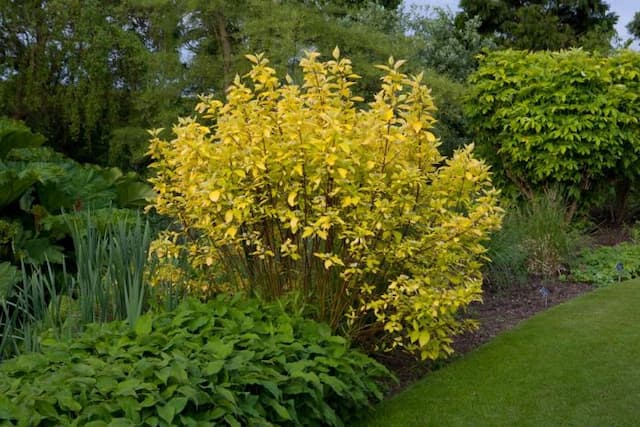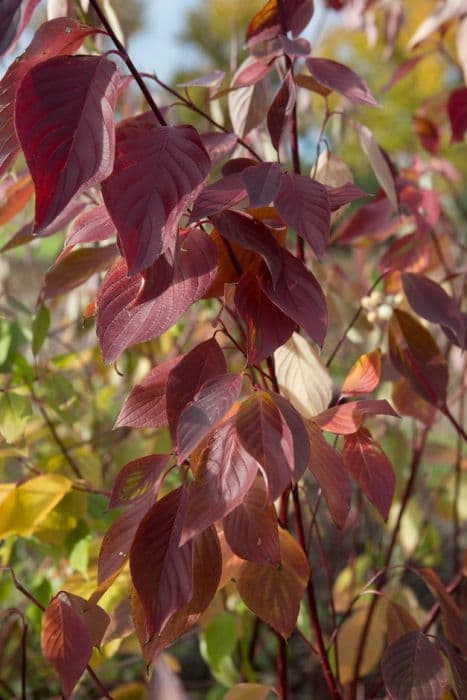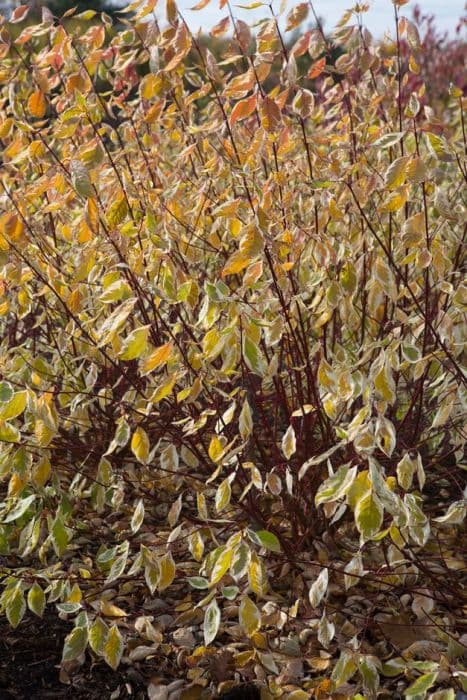Kousa Dogwood Cornus kousa 'Snowboy' (v)











ABOUT
The 'Snowboy' variety of the Kousa dogwood is recognized for its striking ornamental qualities. This plant boasts variegated foliage, where each leaf is uniquely edged with a creamy white or light green border, contrasting beautifully with the green center. Those leaves often appear to have a slightly twisted or wavy contour, adding to the plant's visual interest. During its blooming season in late spring to early summer, 'Snowboy' adorns itself with a profusion of flower-like bracts. These bracts are not true flowers but are modified leaves that surround the plant's diminutive, clustered blooms. For 'Snowboy', the bracts are typically a lush, white color, starting off with a greenish tinge before fully maturing. They form a cross-like pattern, typical of the dogwood family. As the season progresses, the plant may produce ornamental, berry-like fruits, which can attract birds and wildlife to the garden. These fruits are usually a bright red color and add another layer of interest to the plant's already diverse display. The bark of 'Snowboy' is also distinctive, peeling in patterns that reveal mottled shades of brown and gray, giving it a camouflage-like effect that is particularly noticeable in the winter months when the foliage has dropped. Overall, 'Snowboy' Kousa dogwood stands out for its variegated leaves, attractive floral bracts, fruiting bodies, and textured bark, making it a favored choice for a standout specimen in a garden setting.
About this plant
 Names
NamesFamily
Cornaceae
Synonyms
Kousa Dogwood, Korean Dogwood, Chinese Dogwood, Japanese Dogwood
Common names
Cornus kousa 'Snowboy'
 Toxicity
ToxicityTo humans
Kousa dogwood, including the 'Snowboy' variety, is generally considered non-toxic to humans. There are no widely known toxic effects from ingesting parts of this plant. As with many plants, it is always wise to exercise caution and avoid eating plant parts unless they are known to be edible and safe. The fruit of the Kousa dogwood is actually consumed in some cultures. However, individuals should be aware of personal allergies and the possibility of gastrointestinal discomfort if ingested in large quantities or if the individual has a specific sensitivity.
To pets
Kousa dogwood is not known to be toxic to pets. Pets that consume small quantities of kousa dogwood typically do not exhibit signs of poisoning or adverse health effects. However, as with humans, pet owners should be cautious and prevent pets from consuming plants, as individual animals may have varying sensitivities. If a pet consumes a large amount of any plant, including kousa dogwood, it may experience gastrointestinal upset such as vomiting or diarrhea due to the fibrous plant material, rather than specific toxicity. If such symptoms occur, contacting a veterinarian is advisable.
 Characteristics
CharacteristicsLife cycle
Perennials
Foliage type
Deciduous
Color of leaves
Variegated
Flower color
White
Height
8 feet (2.44 meters)
Spread
8 feet (2.44 meters)
Plant type
Shrub
Hardiness zones
5
Native area
Asia
Benefits
 General Benefits
General Benefits- Ornamental Value: Cornus kousa 'Snowboy' (v), also known as the Kousa dogwood, has decorative white to pink flowers that bloom prolifically in spring, adding aesthetic beauty to gardens and landscapes.
- Four Season Interest: This plant provides visual interest throughout the year with its flowers in spring, lush green foliage in summer, striking autumn colors, and interesting exfoliating bark in winter.
- Wildlife Attraction: Its berries attract birds and other wildlife, providing a natural source of food and promoting biodiversity within its environment.
- Low Maintenance: Kousa dogwood is a low maintenance plant, requiring minimal pruning and care once it is established in an appropriate site.
- Disease Resistance: Compared to other dogwoods, Cornus kousa is more resistant to diseases, such as dogwood anthracnose and powdery mildew, ensuring a healthier and more robust plant.
- Shade Tolerance: This species can tolerate partial shade, making it versatile for planting in various garden settings where other sun-loving plants might not thrive as well.
- Drought Tolerance: Once established, the Kousa dogwood has a reasonable level of drought tolerance, making it suitable for regions with occasional dry spells.
- Pollinator-Friendly: The flowers of the Kousa dogwood are attractive to pollinators, such as bees, which is beneficial for the pollination of nearby plants and contributes to the overall health of the local ecosystem.
 Medical Properties
Medical PropertiesThis plant is not used for medical purposes.
 Air-purifying Qualities
Air-purifying QualitiesThis plant is not specifically known for air purifying qualities.
 Other Uses
Other Uses- Culinary Arts: The fruit of Cornus kousa 'Snowboy' can be used for making wine, jams, jelly, and desserts due to its sweet and unique flavor.
- Textile Dye: The bark and roots can be processed to create natural dyes for fabrics, yielding hues of brown and reddish-orange.
- Photography: 'Snowboy' is an excellent subject for garden photography due to its distinctive variegated leaves and the visual interest they add throughout the seasons.
- Floral Arrangements: The branches can be cut and used in floral arrangements, especially when the plant is in bloom or the fruits have emerged, adding depth and texture.
- Crafts: Dried fruits of the plant can be used in homemade crafts, such as wreaths or potpourri, providing a natural and rustic aesthetic.
- Winter Interest: The distinctive variegated foliage, and exfoliating bark provide visual interest in the winter garden landscape when fewer plants are in bloom.
- Ink Production: The berries, once processed, can be used to make natural inks for art or writing purposes.
- Educational Tool: 'Snowboy' can be used in schools or educational programs to teach students about plant variegation, reproductive cycles, and seasonal changes.
- Ecosystem Support: This plant provides a food source for birds, which feast on its berries through the fall and winter.
- Garden Design: Can serve as a natural fence or border due to its dense growth habit, offering privacy and structure to garden spaces.
Interesting Facts
 Feng Shui
Feng ShuiThe Kousa dogwood is not used in Feng Shui practice.
 Zodiac Sign Compitability
Zodiac Sign CompitabilityThe Kousa dogwood is not used in astrology practice.
 Plant Symbolism
Plant Symbolism- Protection: The Cornus genus, which includes the Kousa dogwood, is often associated with protection. Its strong wood was traditionally used to make tools and weapons, symbolically offering strength and defense against adversaries.
- Purity: The 'Snowboy' variety, with its characteristic white bracts that resemble snow, can symbolize purity and innocence.
- Revival: Dogwoods typically bloom in the spring, representing rejuvenation, new beginnings, and the restoration of life after the cold winter months.
- Christian Symbolism: In Christian symbolism, the dogwood is associated with the crucifixion of Jesus, as its flower is said to represent the cross. This association imbues the plant with themes of sacrifice, resurrection, and eternal life.
 Water
WaterThe Kousa Dogwood 'Snowboy' prefers consistently moist soil, so watering should be done once to twice per week, depending on weather conditions. It should be watered deeply, with about 1-2 gallons of water each time, ensuring that the water reaches the root zone without oversaturating the soil. During hot, dry spells, increase watering frequency, but allow the soil to dry slightly between watering sessions. Reduce water intake during the fall and winter when the plant is dormant.
 Light
LightThe Kousa Dogwood 'Snowboy' performs best in partial shade to full sun. Ideally, it should receive morning sunlight and afternoon shade, or dappled sunlight throughout the day. Avoid placing it in a location where it would be exposed to harsh afternoon sun, which can lead to leaf scorch.
 Temperature
TemperatureThe Kousa Dogwood 'Snowboy' is hardy in areas where the temperature ranges between -10 to 75°F. It can tolerate winter temperatures down to -10°F, but prolonged exposure may cause damage. Its ideal growing conditions are in regions with moderate summers, where temperatures do not often exceed 75°F.
 Pruning
PruningPruning the Kousa Dogwood 'Snowboy' is important for maintaining its shape and removing any dead or damaged branches. The best time to prune is late winter or early spring before the new growth starts. Light pruning to shape the tree and thin out dense branches can be done annually, though major pruning should be infrequent.
 Cleaning
CleaningAs needed
 Soil
SoilKousa dogwood 'Snowboy' prefers well-drained, fertile soil with a pH of 5.5 to 7.0. The best soil mix consists of leaf mold, loam, and some sand or perlite for ample drainage. Regular mulching helps retain moisture and maintains soil quality.
 Repotting
RepottingKousa dogwood 'Snowboy', being a tree, is typically not repotted. It's planted in the landscape where it can grow without the need for repotting.
 Humidity & Misting
Humidity & MistingKousa dogwood 'Snowboy' tolerates average outdoor humidity levels. While it can adapt to various conditions, it does best with moderate humidity and adequate soil moisture.
 Suitable locations
Suitable locationsIndoor
Plant kousa dogwood 'Snowboy' in a bright spot with indirect light.
Outdoor
Plant in a sunny spot with partial shade and well-drained soil.
Hardiness zone
5-8 USDA
 Life cycle
Life cycleCornus kousa 'Snowboy', commonly known as Kousa Dogwood 'Snowboy', begins its life cycle as a dormant, variegated seed which requires stratification to break dormancy and germinate. After stratification, it germinates in spring, developing a root system and a shoot bearing its characteristic broad leaves with white and green variegation. This young sapling grows into a mature shrub over several years, producing its distinctive four-petaled white flowers in late spring to early summer, which are followed by pinkish-red, berry-like fruits in late summer to autumn. Throughout the growing season, Kousa Dogwood 'Snowboy' undergoes vegetative growth, adding new branches and leaves. During autumn, the foliage changes to show off impressive fall colors before entering dormancy in winter as it loses its leaves. With each spring, the cycle starts anew with fresh growth and flowering, continuing for many years as the shrub matures and becomes more prolific.
 Propogation
PropogationPropogation time
Late winter-early spring
The Cornus kousa 'Snowboy', commonly known as the variegated Kousa dogwood, is often propagated by softwood cuttings during late spring to early summer. To apply this method, a gardener would cut a 4-6 inch (10-15 cm) portion of the plant's softwood branch, which is the current year's growth that has not yet hardened. The bottom cut should be made just below a node, and the leaves at the lower end of the cutting should be removed. The cutting is then typically dipped in a rooting hormone to enhance root development and planted in well-draining soil or a soilless potting mix. It is important to maintain high humidity around the cutting, which can be achieved by covering the pot with a plastic bag or placing it inside a propagator, to forestall the cutting from drying out before it has a chance to root.

![Dogwood [Baton Rouge]](/_next/image?url=https%3A%2F%2Fplants-admin.emdemapps.com%2Fimages%2Fplants%2F%2Fimages%2F604b59cf0fefd.png&w=640&q=75)


![Dogwood [Ivory Halo]](/_next/image?url=https%3A%2F%2Fplants-admin.emdemapps.com%2Fimages%2Fplants%2F%2Fimages%2F604b535cbcb9a.png&w=640&q=75)




